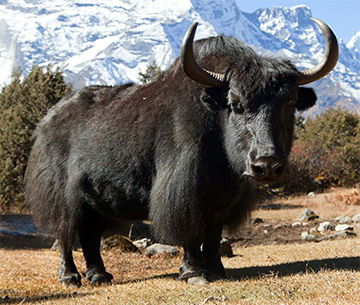High-Altitude Yak | 10 Jul 2021
Why in News
Recently, the National Research Centre on Yak (NRCY) at Dirang in Arunachal Pradesh’s West Kameng district has tied up with the National Insurance Company Ltd. for insuring the high-altitude yak.
- NRCY is a premier research institute exclusively engaged in research and development of yak in India. It was established in 1989 by the Indian Council of Agricultural Research.
Key Points
- About:
- The Yak belong to the Bovini tribe, which also includes bison, buffaloes, and cattle. It can tolerate temperatures as low as-40 degrees Celsius.

- Adapted for living at high altitudes, they have long hair that hangs off their sides like a curtain, sometimes touching the ground.
- Yaks are highly valued by Himalayan peoples. According to Tibetan legend, the first yaks were domesticated by Tibetan Buddhism founder Guru Rinpoche.
- They are also known as the lifeline of pastoral nomads in high altitudes of the Indian Himalayan region.
- The Yak belong to the Bovini tribe, which also includes bison, buffaloes, and cattle. It can tolerate temperatures as low as-40 degrees Celsius.
- Habitat:
- They are endemic to the Tibetan Plateau and the adjacent high-altitude regions.
- Yaks are most comfortable above 14,000 feet. They climb to an elevation of 20,000 when foraging and usually don't descend any lower than 12,000 feet.
- The yak-rearing states of India are Arunachal Pradesh, Sikkim, Uttarakhand, Himachal Pradesh and Jammu & Kashmir.
- The countrywide population trend shows that the yak population has been decreasing at an alarming rate. The total yak population in India is about 58,000.
- They are endemic to the Tibetan Plateau and the adjacent high-altitude regions.
- Threats:
- Climate Change:
- The increasing trend of environmental temperature at high altitudes is resulting in heat stress in yak during warmer months of the year. This, in turn, is affecting the rhythms of physiological responses of the animal.
- Inbreeding:
- As wars and conflicts have led to the closing of borders, the yaks outside borders are thought to be suffering from inbreeding due to the lack of availability of new yak germplasm from the original yak area.
- Climate Change:
- Protection Status of Wild Yak (Bos mutus):
- IUCN Red list status: Vulnerable
- IUCN considers the wild species of yak under Bos mutus, while the domestic form is considered under Bos grunniens.
- CITES: Appendix I
- Indian WildLife (Protection) Act of 1972: Schedule I
- IUCN Red list status: Vulnerable
